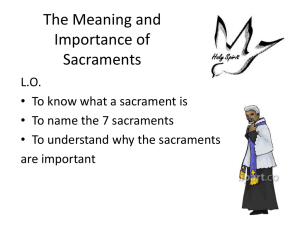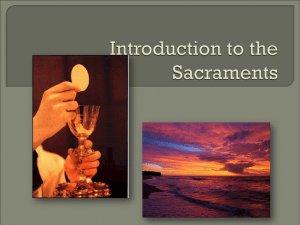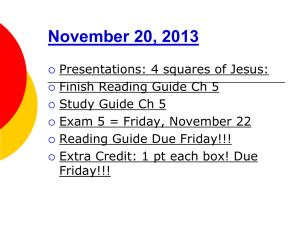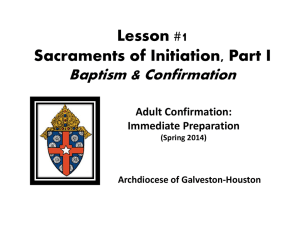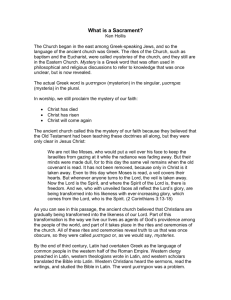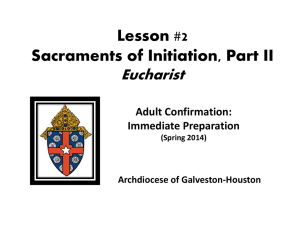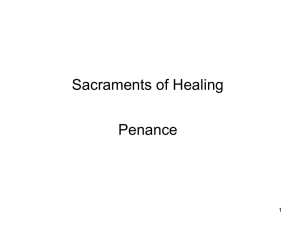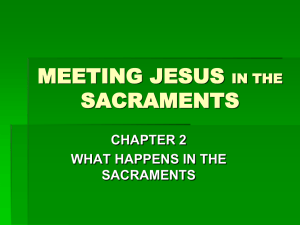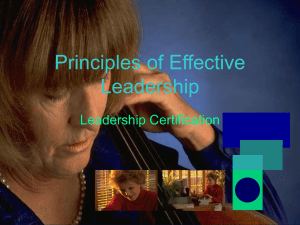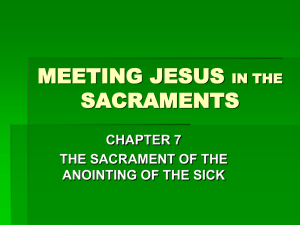The Sacraments of Initiation
advertisement
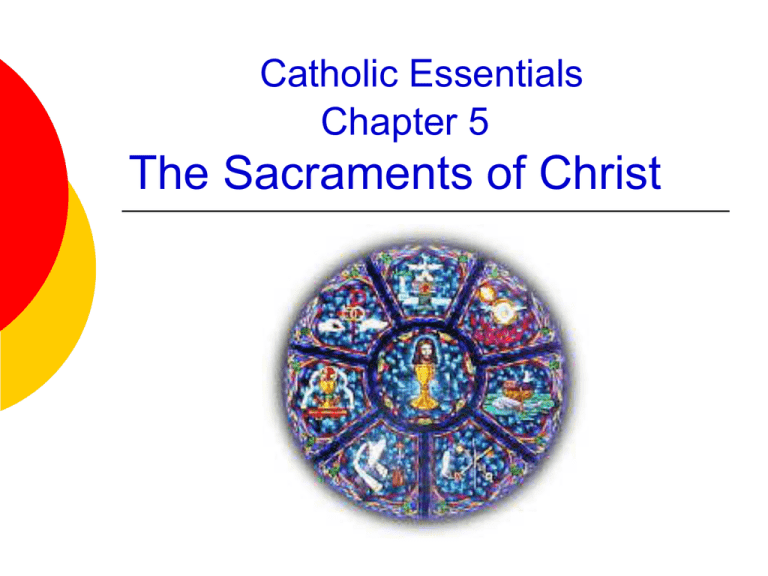
Catholic Essentials Chapter 5 The Sacraments of Christ Sign, Symbol, Sacrament St. Thomas Aquinas taught that human development is marked by seven stages which parallel the seven sacraments. We are born: Baptism We grow: Confirmation We are fed: Eucharist We are healed: Penance We recover: Anointing of the Sick We need and form family: Matrimony We need and respond to leaders: Holy Orders Signs and Symbols Three definitions of Sacrament St. Paul – sacramentum = mysterion God’s hidden plan to fulfill all things in Christ. St. Augustine stressed sign and symbol (something concrete that points to something else.) St. Thomas Aquinas added that sacraments are efficacious signs or symbols of grace. They effect, cause, and are what they signify. Sacraments ARE what they symbolize To be a sacrament, a sign or symbol must do the following: Lead us to God Come from God Be an action of God The best example of a sacrament is Jesus Christ himself. The Primordial Sacrament Jesus is the starting point of all sacraments. Jesus is the perfect sign of God’s great love for us. The fundamental nature of a sacrament is revealed in Jesus. Liturgy (the Work of the People) The first and most important work of the Church is to make present Christ’s Paschal Mystery here and now. We do this in liturgy. All the sacraments are liturgy – the work of the people…none are private affairs. Every sacrament is a community affair – an affair of the Church. Jesus is really present in Eucharist Jesus is present in the priest, the minister of the sacrament. Jesus is present when the Holy Scriptures are read. Jesus is present in the community assembled Jesus is really present in the consecrated species of bread and wine. The Church as Sacrament The Church is a mystery. The Church is beloved of Christ. The Church is an efficacious symbol. Council of Florence Proper matter – the prescribed materials. Correct words or form – the prescribed words and gestures. Designated minister – the prescribed minister. The Seven Sacraments The Sacraments of Initiation – Baptism, Confirmation, Eucharist. The Sacraments of Healing – Reconciliation (Penance), Anointing of the Sick. The Sacraments at the Service of Communion – Matrimony, Holy Orders. Sacraments of Initiation Baptism – brings new life in Christ. Confirmation – strengthens our new life with the gifts of the Holy Spirit. Eucharist – nourishes us with the Body and Blood of Christ. Baptism Rites Rite of Christian Initiation of Adults (RCIA) - A process for adults culminating in the celebration of all three sacraments of initiation at the Easter Vigil. Rite of Baptism of Children - People did not want their children to wait until adulthood to be reborn in Christ’s life…infant baptism became prevalent. Four Steps of RCIA Evangelization – a person hears the word of God and responds to it. It is followed by a rite of acceptance Catechumenate – over the course of a year, catechumens study the faith in special parish classes, are mentored by a sponsor, do service, and participate in the Liturgy of the Word at Mass. On the first Sunday of Lent, candidates are enrolled in the Book of the Elect by the bishop. Four Steps of RCIA Purification and Enlightenment – During Lent, catechumens scrutinize their lives and do penance. They receive the Lord’s Prayer and the Creed on which to center their lives. At the end of this period they receive the three sacraments of initiation at the Easter Vigil Mass. Mystagogia – The newly baptized neophytes continue to meet with one another after Easter until Pentecost, gradually taking their place in the Church. “Cradle Catholics” Most Catholics are initiated into the Church as infants through the Rite of Baptism of Children. The child’s parents and godparents speak in the name of the child. Catechesis takes place after baptism. Formation is gradual as the child grows The other sacraments of initiation are received at a later time. The Essential Rite of Baptism Proper matter: Water Correct words or form: Triple pouring of or immersion in water with the words, “I baptize you in the name of the Father, and of the Son, and of the Holy Spirit.” Designated minister: bishop, priest, or deacon Effects of Baptism Washes away original sin and any other sins and the punishment due. Makes us children of God and temples of the Holy Spirit. Welcomes us as members of the Church, the Body of Christ. Marks us forever as sharers in the common priesthood of all believers, and in Christ’s mission of justice and peace. Celebration of the Sacrament of Baptism Requirements for Reception of the Sacrament of Confirmation Be prepared to profess the faith. Be in the state of grace. Intend to receive the sacrament. Be prepared to witness to Jesus Christ. The Essential Rite of Confirmation Proper matter: Chrism Correct words or form: Laying on of hands and anointing with chrism on the forehead with the words: "(Name), be sealed with the gift of the Holy Spirit." Designated minister: Bishop Development of the Eucharist Christ instituted the Eucharist during a Passover meal held at the Last Supper as a memorial of his Death and Resurrection. At the Council of Trent (1545 – 1563) the doctrine of transubstantiation was defined and the Roman Missal was published by Pope Pius V. The Essential Rite of Eucharist Proper matter: unleavened bread and wine Correct words or form: Changing bread and wine into the Body and Blood of Christ by the words: "Take this, all of you, and eat it: this is my body which will be given up for you . . . Take this, all of you, and drink from it: this is the cup of my blood of the new and everlasting covenant. It will be shed for you and for all so that sins may be forgiven. Do this in memory of me.“ Designated minister: Bishop or priest Parts of the Eucharistic Liturgy Introductory Rites Sign of the Cross Penitential Rite Gloria Opening Prayer Liturgy of the Word First Reading Psalm Response Second Reading Gospel Homily Creed General Intercessions Liturgy of the Eucharist Preparation of the Altar Presentation of the Gifts Eucharistic Prayer Great Amen Communion Rite Our Father Lamb of God Reception of Holy Communion Prayer after Communion Concluding Rite Sacraments of Healing Anointing of the Sick Penance / Reconciliation Our new life in Christ can be weakened by suffering, illness, death, and the effects of sin. Penance – Reconciliation - Confession Penance renews, restores, and strengthens our relationship with God and the community after it has been damaged by sin. Penance shows that God’s love is without limits Healing and Forgiveness Essential Elements of Penance The acts of the person who undergoes conversion The intervention of the Church Contrition Confession Satisfaction Absolution from the priest All Catholics are required to go to confession at least once per year to confess serious sins God Alone Forgives Sin Christian life is marked by lifelong conversion Even though forgiveness is expressed through the Church and this Sacrament, God alone forgives sin Anointing of the Sick The sacrament encourages those who are sick to overcome the alienation caused by illness Jesus continues to bring healing through the prayers of the Church, and through the sacraments, especially the Eucharist and the Anointing of the Sick History of Anointing of the Sick In the Middle Ages the sacrament was administered only to the dying and was called Extreme Unction – “the Last Anointing.” Viaticum – is the final reception of the Eucharist. Since Vatican II, this sacrament is celebrated for those suffering from serious illness, for the elderly, for those facing major surgery -- and for the dying. Essential Elements of Anointing of the Sick The priest or bishop • lays his hands on the sick person prays for the person in the faith of the Church anoints the forehead and hands of the sick person with oil previously blessed by a bishop Sacraments at the Service of Communion These sacraments are directed toward the salvation of others, not toward those receiving the sacraments. Matrimony Holy Orders Holy Orders The ministerial priesthood Sacramental ordination consecrates certain baptized men to one of three degrees of a sacred order: Episcopate – bishops Presbyterate – priests Diaconate – deacons Essential Rite of Holy Orders A call by God to serve the Church in a very special way. Essential rite includes: the laying on of hands by the bishop accompanied by a special prayer of consecration. An indelible spiritual character is conferred on the ordained man. Matrimony Marriage is a sacred covenant -that is an agreement between the husband and wife, and between the couple and God. Matrimony From the time of creation, marriage has been an institution established by God, not by man. Sacramental marriage was modeled on the relationship between Christ and the Church The goodness of Marriage includes: The procreation of children. The chastity of the spouses and their fidelity to each other. The indissoluble union of marriage. The Essential Rite of Matrimony The essential element of Matrimony is the mutual consent to marry. The words of consent must be freely given. Catholics must marry in the presence of a priest or a deacon, and in the presence of two witnesses. The spouses themselves are the ministers of the sacrament. Matrimony The family is called “the domestic Church.” The family is a living witness and testimony of eternal, unbreakable, and boundless love that the couple (and their children) give to one another and to the world. The Seven Sacraments The sacraments celebrate Jesus as the Way, the Truth, and the Life. The sacraments are a way for us to live life to the fullest. The sacraments are the way to allow Jesus to touch our lives.
